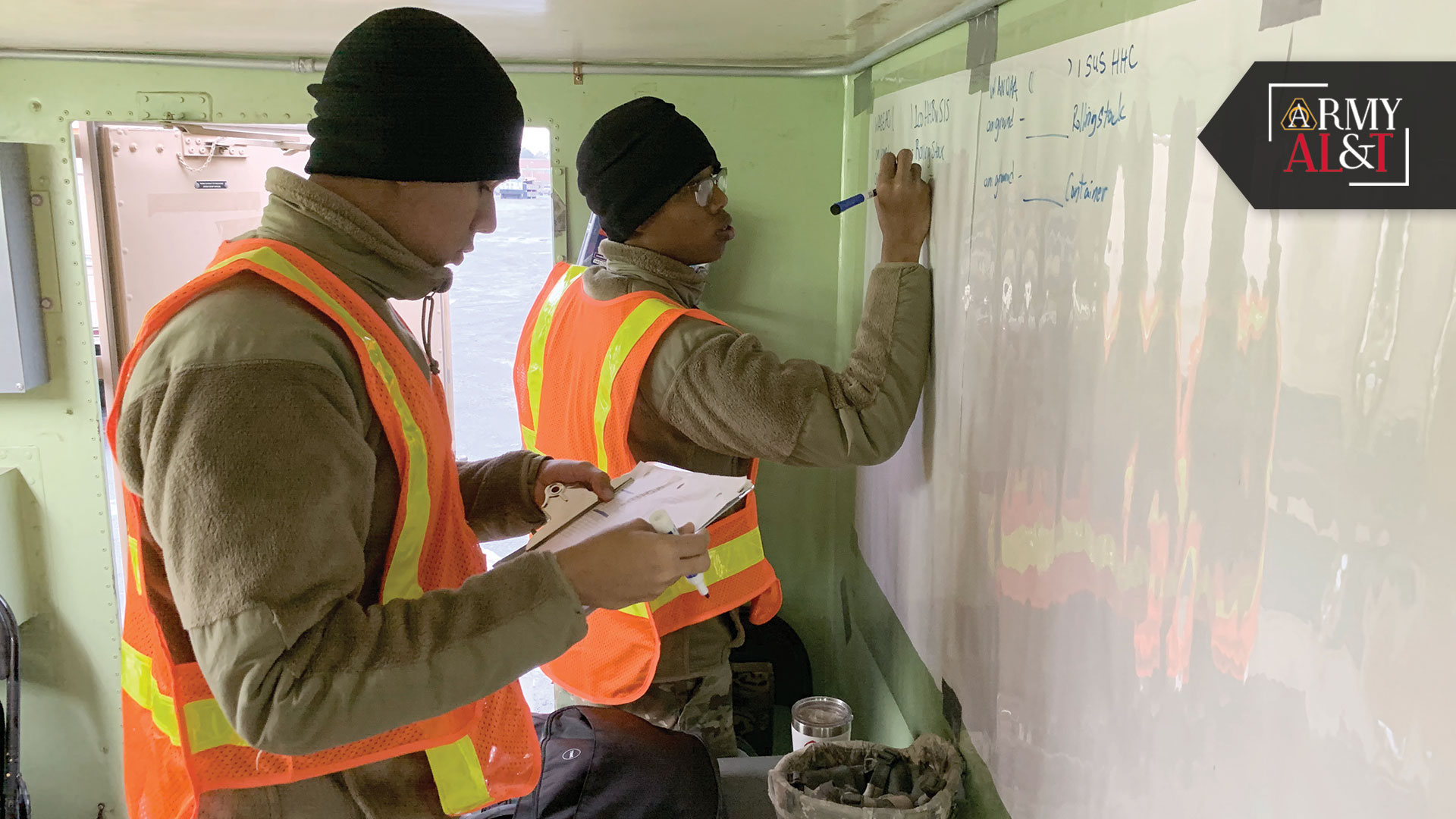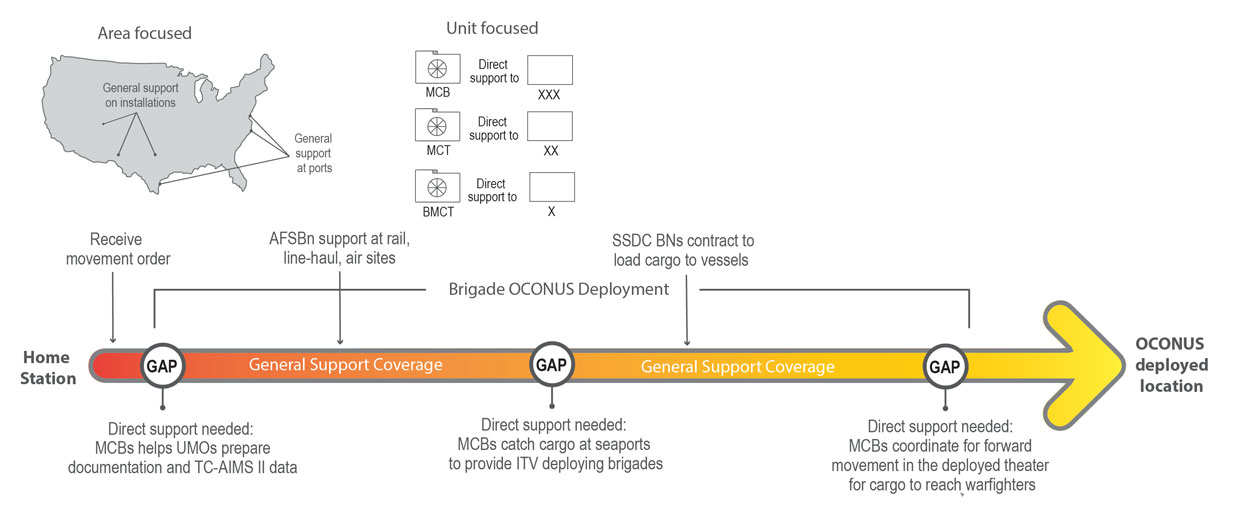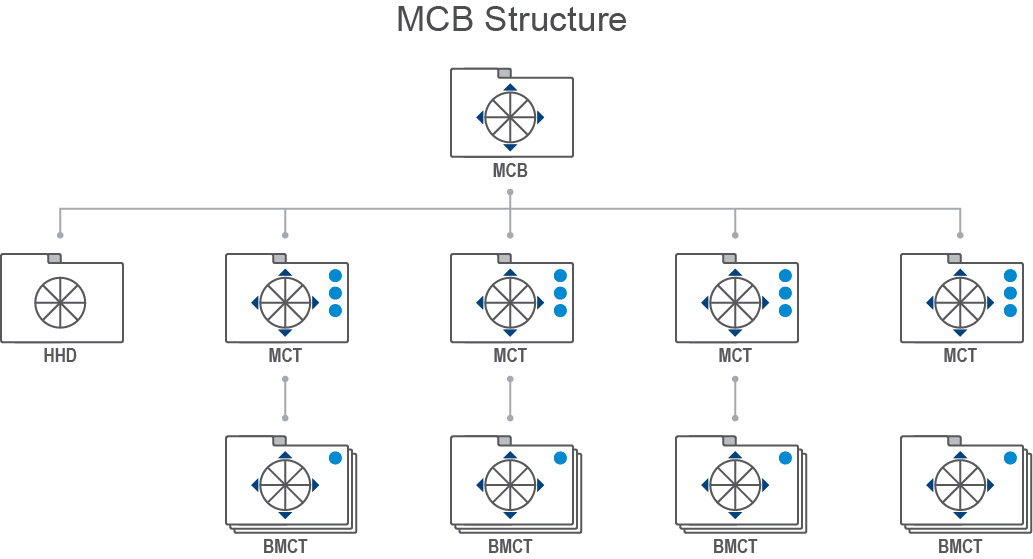
DRAWING UP PLANS: Members of 80th MCT support multiple III Corps units at Port Arthur, Texas, in anticipation of the Defender-Europe 2020 deployment. (U.S. Army photo by Sgt. First Class Horacio Chanyau)
49th Movement Control Battalion’s early coordination and expanded services improve movements for deploying units, providing on-site expertise and allowing greater visibility of cargo in transit.
by Maj. Stephen W. Hughes and Maj. Carl S. Miller
Movement control battalions need to train during their day-to-day operations in the U.S. to be prepared to facilitate movement during large-scale combat operations when the need arises. While it is said that an army marches on its stomach, there is a great deal more to moving an army than just feeding it. Movement control can mean the difference between victory and defeat.
In large-scale combat, or even in a blended fight, the enemy will target and may be able to affect sustainment bases, roads, information systems and strategic lines of communication. U.S. ground combat forces will seek to advance toward and through the enemy on a broad front. These advancing U.S. forces will press forward on multiple highways and back roads, spread hundreds of miles apart, to avoid vulnerability from weapons of mass destruction. During the offensive, movement control battalions (MCBs) can help maintain order, extend operational reach and increase velocity by adding regulation and stability where otherwise there would be chaos in the massive movement of cargo and supplies.
There is a delineation of the lines of responsibility between MCBs and other deployment support units that is not always apparent, but will be outlined below. The doctrinal model advocated below seeks to widen the scope of duties of MCBs beyond their traditional roles. In the U.S. Army’s current deployment practices, brigades lose sight of their cargo once it departs from their military installation. But in the spirit of doctrine, the MCB should be expeditionary and track cargo to air and sea ports, subsequently providing updates to deploying units until their ships and planes have departed port. In pursuit of that goal, the 49th MCB has become a customer-service-oriented organization that works directly for deploying units. In doing so, the MCB enables its customers to deploy further and faster without pause or loss of accountability.

MIND THE GAPS: The MCB would have to fill in the gaps between tactical deploying units and the support elements at installation and commercial shipping sites. (Image by U.S. Army Acquisition Support Center (USAASC))
THE GENESIS
In May 2019, the 49th Transportation Battalion (MCB) completed a nine-month rotation to Poland in support of Operation Atlantic Resolve. It facilitated the movement of all military convoys into and out of numerous states by liaising with national elements to authorize and control the movement, ensuring the completion of customs paperwork and assisting units when foreign authorities frustrated or delayed their cargo. Upon return from Europe, the 13th Expeditionary Sustainment Command’s commanding general, Brig. Gen. Darren L. Werner, delivered his vision of the “MCB of the corps” model to the 49th MCB Commander, Lt. Col. Travis Sept.
His vision mirrored doctrine and is described in Army Technical Publication 4-16, Movement Control. However, MCBs do not follow the model in practice today. To bring Werner’s vision about, the 49th MCB would become a III Corps force multiplier, operating both on and off Fort Hood, Texas, and wherever III Corps’ subordinate units traveled. On-site support would be provided for brigades and divisions on installations, at training centers and at air and sea ports for deployments. This tiered support in the United States would discipline and posture the MCB and translate to supporting large-scale combat operations abroad when needed, as described in Field Manual 3-0.
The MCB would have to fill in the gaps between tactical deploying units and the support elements at installation and commercial shipping sites. Army field support battalions and U.S. Army Military Surface Deployment and Distribution Command offer general support to deploying units at operational installation deployment nodes and strategic commercial ports globally. Their general support is to the Army as a whole, and not to any specific unit. It is passive and not targeted.
The direct support provided by an MCB, however, supports specific forces, and the MCB answers directly to the deploying unit. Deploying units need this. When experts do not go to the brigade’s area of operations in active pursuit to aggressively assist the unit weeks before their scheduled date to put their equipment on trains, the brigade fails. Branch movement control teams align with brigades on a regular basis, and movement control teams (MCTs) align with divisions as well. This alignment provides maneuver commanders greater understanding and influence in their efforts to closely track combat power and make operational decisions based on when resources will arrive in theater.
Today, brigade and subordinate unit movement officers report to installation Army field support battalion representatives at deployment nodes for technical expertise, as their unit readies for deployment. However, many unit movement officers are uninformed of the specifics of their duties and fail to contact the Army field support battalion in time. This is where the MCB should fill in the gap. To do this, MCBs select and send members of subordinate MCTs to deploying units months before the start of the cargo deployment dates. Those teams, four-Soldiers in size, then work with brigade movement officers while they select which pieces of equipment will deploy and in inputting dimensional configurations into the Army’s computerized deployment program, which is difficult without knowhow on the highly technical requirements for movements by rail, sea and air.
Installation Army field support battalions coordinate with Surface Deployment and Distribution Command and brigade mobility warrant officers to obtain cargo deployment lists and complete the commercial booking for that cargo to move. The command also coordinates the movement windows in which units are expected to have cargo available at rail and line-haul sites. However, after the cargo leaves the military installation, the brigade has to seek out the location of its cargo using unreliable in-transit visibility websites. The command does not actively update and feed information to the brigade mobility warrant officers or influence the velocity of cargo movement at ports, beyond what was requested in the original commercial booking. As a strategic general support element, it is not the command’s role to feed information to the tactical brigade as a specific customer. However, with the direct support of an MCT, the brigade receives real-time data on cargo location and gains active assistance to spur movement of stagnant cargo.

HOW MOVEMENT CONTROL BATTALIONS WORK: A movement control battalion (MCB) is organized with four 21-Soldier movement control teams (MCTs) and 16 four-Soldier branch movement control teams (BMCTs). (Image by USAASC)
PITCH AND CATCH
According to Army Technical Publication 4-16, MCBs provide support to units within a theater of operations and they assist tactical units in gaining transportation support that comes from outside of the theater of operations. Within the U.S., III Corps’ divisions and brigades use the 49th MCB to provide in-transit visibility of personnel, supplies and equipment moving through the transportation system. It also provides assistance with the minutiae of military cargo shipping in the ramp-up to deployment and while the cargo is in the deployment pipeline.
The 49th MCB, with four assigned MCTs and 16 branch movement control teams of four personnel each, can potentially cover 16 deployment sites. This has allowed the 49th MCB to conduct “pitch and catch” operations with deploying cargo. For instance, in October and November 2019, three branch movement control teams at Fort Hood, Texas, staged at the installation’s commercial trucking yards and railroad loading sites to send cargo to Fort Irwin, California, during a 3rd Cavalry Regiment National Training Center rotation. The branch movement control teams provided the regiment visibility of its combat power build, before the start of the exercise and then again on return to home station.
While Surface Deployment and Distribution Command and the Army field support battalions remain focused on running the day-to-day operations at ports, railheads and convoy yards, MCBs directly support the corps’ subordinate units as customers. As such, while the 49th MCB headquarters is located at Fort Hood, the MCTs deploy and operate wherever III Corps units need them.
For the ramp up to Defender-Europe 20 exercise (planned to be the largest training exercise in Europe in 25 years), the 49th MCB deployed teams to Fort Bliss, Texas, supporting the 1st Armored Division; to rail and sea nodes at the Port of Beaumont and Port Arthur, supporting the 1st Cavalry Division; and to Fort Hood’s railroad locations and airports, supporting multiple III Corps’ and National Guard units. In addition, the 49th MCB deployed four small teams to Poland to support Defender-Europe 20 units and planned to send another two in April 2020, before the unexpected halt of the exercise because of the spread of COVID-19.

FINAL PREPARATIONS: Members of the 259th MCT support 2nd Brigade, 1st Cavalry Division at Fort Hood during the Speed of War Exercise 2019. (U.S. Army photo by Spc. Jonathan Haygood)
CONCLUSION
The work of building relationships, training Soldiers and incorporating branch movement control teams into the deployment process to fill in gaps and assist deploying units is having positive effects today. As of April 2020, the 49th MCB headquarters is deployed to New Orleans, where it is serving as the movement control lead for the 377th Theater Support Command over three Expeditionary Sustainment Commands. The 49th MCB will soon have six to eight MCTs apportioned to them, to control the movement of doctors, nurses, hospital support personnel and associated supplies to points of need.
By training Soldiers in MCTs to work at installation support nodes before the spread of COVID-19 and training the headquarters staff to track and direct the work of the MCTs at deployment sites, the 49th has ensured that cities get what they need when they need it. The battalion will deploy branch movement control teams to cities across the U.S. to work at makeshift convoy rally points and at commercial airports. While different than the expected mission, the 49th MCB is prepared to fight COVID-19 because of the work it conducted to prepare for a near-peer threat.
Post-COVID-19 response, the 49th MCB will further build relationships with Surface Deployment and Distribution Command’s 833rd and 834th Transportation Battalions with seaports on the West Coast, the 841st Transportation Battalion on the East Coast and the 842nd Transportation Battalion in Texas. By 2021, the 49th also plans to mirror its Fort Hood partnerships with the Army field support battalions at other large posts containing III Corps subordinate units: Fort Bliss; Fort Riley, Kansas and Fort Carson, Colorado. Integrating dispersed MCTs directly into the work at Army field support battalions will both build the capability of the corps and act as a force multiplier for the corps’ subordinate divisions.

CARGO INSPECTION: The 49th MCB Command Team inside of a commercial vessel inspect cargo for 2nd Brigade Combat Team, 1st Infantry Division’s deployment to Pacific Command at Grays Harbor, Washington, in January. (U.S. Army photo by Maj. Stephen Hughes)
For more information, contact the 49th Movement Control Battalion at 254-287-1664 or see Army Technical Publication 4-16, Movement Control.
MAJ. STEPHEN W. HUGHES is the battalion S-3, 49th Movement Control Battalion at Fort Hood. He holds an MBA from the University of Utah and a bachelor’s degree in political science from Utah State University.
MAJ. CARL S. MILLER is the battalion executive officer for the 49th Movement Control Battalion at Fort Hood. A graduate of the Advanced Military Studies Program, he holds an M.S. in psychology from the University of Phoenix, an M.A. from the Command and General Staff College in military operations and a B.A. in history from Stephen F. Austin State University.
Read the full article in the Summer 2020 issue of Army AL&T magazine.
Subscribe to Army AL&T News – the premier online news source for the Army Acquisition Workforce. ![]() Subscribe
Subscribe







